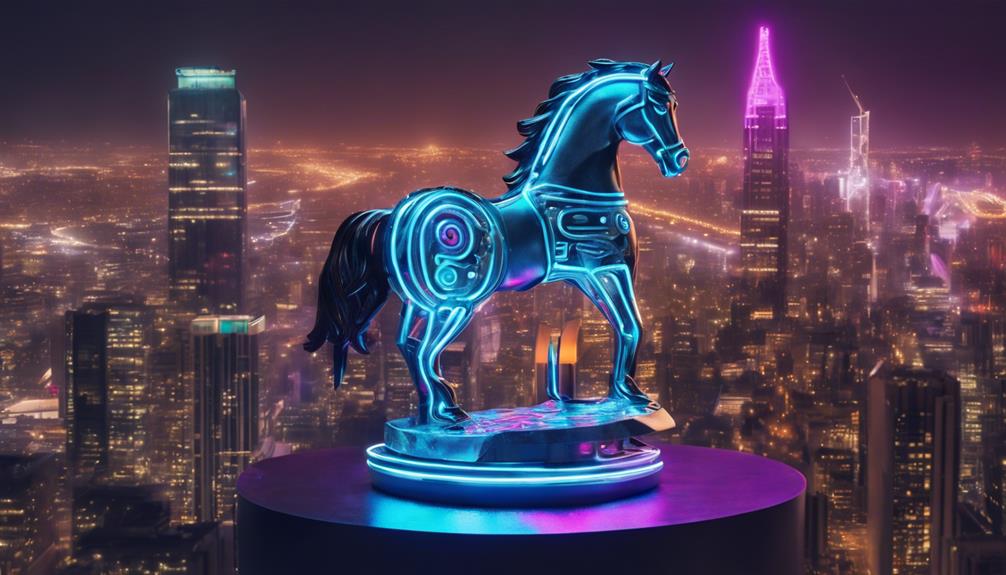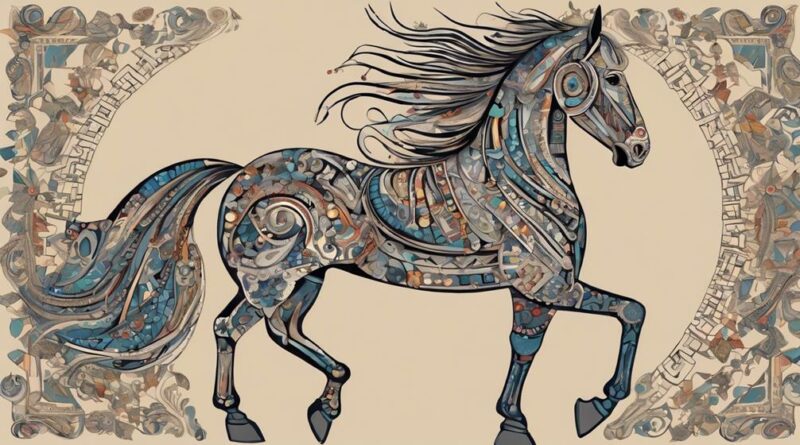What Signifies Horse Imagery in Various Cultures?
Did you know that horses have been depicted in art for over 16,000 years? From ancient cave paintings to modern interpretations, the symbolism of horses in various cultures is rich and diverse.
Explore how these majestic creatures have captured the imagination of people around the world, revealing insights into the values, beliefs, and traditions of different societies.
Ancient Greek Depictions of Horses
Ancient Greek artists frequently portrayed horses as symbols of strength and nobility in their artwork. These majestic creatures held significant roles in Greek mythology, with the mythological equine Pegasus being one of the most iconic examples. Pegasus, the winged horse, was seen as a symbol of wisdom and fame, often associated with the Muses and poetry.
Moreover, horses in Ancient Greek art often carried warhorse symbolism, representing power and valor in battle. The Greeks valued the speed, agility, and strength of horses in warfare, and these attributes were reflected in their artistic depictions. Scenes of fierce battles and heroic warriors mounted on powerful steeds adorned pottery, sculptures, and paintings, emphasizing the importance of horses in Greek military culture.
The intricate detailing in Greek artwork captured the essence of these mythological and warhorse symbols, showcasing the grace and majesty of these animals. From elaborate friezes on temples to intricate vase paintings, horses were central figures in conveying themes of strength, courage, and nobility.
Symbolism of Horses in Native American Art
In Native American art, horses symbolize freedom and connection to the spiritual world. This symbolism is deeply rooted in the cultural connections and artistic expressions of various Native American tribes.
- Spiritual Connection: Horses are often depicted in Native American art as conduits between the physical and spiritual realms, embodying the idea of spiritual journeys and guidance.
- Cultural Significance: The presence of horses in Native American art reflects the historical and cultural importance of these animals to many tribes, symbolizing strength, power, and resilience.
- Freedom and Movement: The dynamic portrayal of horses in Native American art conveys a sense of freedom and movement, illustrating the nomadic lifestyle of many tribes and their connection to the land.
Through intricate designs and symbolic representations, Native American artists use horses to convey deeper meanings and narratives that speak to the essence of their cultural identities. These artistic expressions not only celebrate the beauty and grace of horses but also serve as a visual language through which stories, traditions, and beliefs are passed down through generations.
Horse Motifs in Chinese Art
Horse motifs in Chinese art similarly hold significant cultural symbolism and artistic expression, showcasing a distinct interpretation of equine imagery within a different cultural context. In Chinese art, horses are frequently depicted in calligraphy, where their symbolism is deeply rooted. The strokes and flow of the characters in calligraphy often mimic the movements of a horse, symbolizing speed, grace, and strength. This connection between the written characters and the physical attributes of the horse reflects a harmonious blend of artistry and cultural significance.
Moreover, equine motifs can also be found in Chinese pottery, where horses are portrayed in various forms such as figurines, vases, and decorative items. These pottery pieces not only showcase the artistic skills of the craftsmen but also carry symbolic meanings. In Chinese culture, horses symbolize success, loyalty, and prosperity. By incorporating horse motifs into pottery, artists convey these positive attributes to the viewers, bringing good fortune and auspiciousness into their lives.
Horses in Medieval European Art
Medieval European art vividly captures the essence of horses through intricate depictions that reflect the cultural beliefs and societal values of the time period. During the Middle Ages, horses were more than just animals; they held symbolic significance that permeated various facets of life.
- Medieval Equestrian Symbolism: Horses in medieval European art often symbolized power, strength, and nobility. They were frequently depicted carrying knights into battle or representing the chivalric ideals of the era.
- Equine Iconography: Artists utilized horses as symbols to convey religious or mythological themes. These majestic creatures were featured in manuscripts, sculptures, and tapestries, adding layers of meaning to the artworks.
- Horse Allegories and Medieval Equine Representations: Beyond their physical presence, horses in medieval European art served as allegories for virtues like courage, loyalty, and honor. Through these representations, artists conveyed moral lessons and societal expectations to the viewers.
The intricate details and symbolic meanings attributed to horses in medieval European art showcase the deep-rooted significance of equine imagery in the cultural landscape of the time. Whether charging into battle or standing as a symbol of virtue, these representations of horses continue to fascinate and resonate with viewers, providing insights into the values and beliefs of the medieval period.
Japanese Equine Art Representations
Japanese artists skillfully depict horses in their artwork, capturing the essence of equine grace and power with exquisite detail. In Japanese culture, horses hold significant symbolism representing strength, loyalty, and success. These representations can be found in various forms of art, such as paintings, sculptures, and even in traditional ceremonies.
Japanese horse symbolism often emphasizes the connection between horses and noble qualities like perseverance and victory. Horses are frequently portrayed in full gallop, symbolizing speed and agility, traits highly valued in Japanese society. The intricate details in these artworks showcase the artists' mastery of equine art techniques, such as capturing the fluid movement of horses and the intensity in their eyes.
Equine art techniques in Japanese representations often involve the use of bold lines and vibrant colors to convey the energy and dynamism of these majestic creatures. Whether depicted in battle scenes or serene landscapes, horses in Japanese art evoke a sense of power and beauty.
African Horse Imagery in Art
Exploring the rich tapestry of African art reveals a diverse array of captivating horse imagery that reflects the cultural significance and artistic expressions of various communities. In African culture, horses hold symbolic importance and are often depicted in art forms as a representation of power, strength, and freedom.
- Horses in African art are frequently portrayed as majestic and regal creatures, symbolizing leadership and authority within the community.
- The artistic expressions of horses in African art vary across regions, showcasing the diversity of cultural interpretations and beliefs surrounding these animals.
- African artists use a variety of mediums, such as painting, sculpture, and textiles, to capture the essence of horses in their work, highlighting the enduring connection between humans and these magnificent animals.
Through these intricate artistic representations, African communities pay homage to the role of horses in their heritage and traditions. The intricate details and symbolism woven into these artworks provide a glimpse into the deep-rooted reverence for horses within African culture. Whether depicted in a realistic or abstract manner, horse imagery in African art continues to serve as a visual reminder of the profound impact these animals have had on the cultural tapestry of the continent.
Modern Interpretations of Horses

Capturing the essence of contemporary creativity, artists today reinterpret horse imagery through a myriad of innovative perspectives and mediums. In modern interpretations of horses, artists delve into the realm of contemporary symbolism and cultural interpretations, infusing new meanings into this age-old symbol.
Contemporary artists often use horses as a symbol of freedom, strength, and power in their work. Through paintings, sculptures, and digital art, horses are depicted in dynamic and abstract ways, reflecting the ever-evolving nature of the human-animal connection. These modern interpretations not only showcase the beauty and grace of horses but also explore deeper themes such as resilience, endurance, and the human spirit.
Moreover, artists draw inspiration from diverse cultural interpretations of horses, blending traditional symbolism with contemporary art techniques. The fusion of different cultural perspectives adds layers of complexity to the portrayal of horses in modern art, inviting viewers to ponder on the universal themes that these magnificent creatures represent across various societies.
Spiritual Significance of Horses in Art
Delving into the spiritual realm, artists have long imbued their depictions of horses with profound symbolic significance in art. Horses have been utilized as powerful symbols across various cultures and artistic movements, representing deeper meanings beyond their physical form.
- Symbolic representations: In art, horses often symbolize strength, freedom, and grace. They can embody qualities like power, nobility, and resilience, serving as a metaphor for human experiences and emotions. Artists use horses to convey messages of courage, determination, and the unbreakable spirit.
- Spiritual connections: Many cultures attribute spiritual significance to horses, viewing them as messengers between earthly and divine realms. Horses are seen as sacred beings that possess a special connection to spiritual forces, guiding and protecting individuals on their journeys. Artists frequently incorporate this spiritual essence into their works, infusing their horse imagery with a sense of mysticism and reverence.
- Cultural meanings, artistic interpretations: The interpretation of horses in art varies widely across different cultures. From the majestic stallions of European paintings to the mystical steeds of Asian folklore, horses hold diverse cultural meanings that artists explore through their creations. Each depiction reflects unique cultural perspectives and artistic interpretations, enriching the symbolic depth of horse imagery in art.
Frequently Asked Questions
How Did Horses Influence the Development of Warfare Tactics in Ancient Cultures?
Horses revolutionized ancient warfare strategies by enabling faster and more mobile cavalry tactics. Their speed and strength on the battlefield changed the way battles were fought, providing a significant advantage in combat.
Are There Any Superstitions or Beliefs Surrounding Horses in Different Cultures?
In different cultures, horses are steeped in superstitions and symbolism. They're often seen as symbols of power, freedom, and strength. Some cultures have specific taboos surrounding horses, believed to bring bad luck if broken.
In folklore, horses are connected to mythical creatures and heroes, embodying qualities like loyalty and bravery. Understanding these beliefs can offer insight into the deep-rooted cultural significance of horses across the world.
What Role Did Horses Play in Trade and Transportation in Various Historical Societies?
Horses were pivotal in trade routes and transportation methods in various historical societies. They enabled the swift movement of goods and people across vast distances, shaping the development of economies and cultures.
Their speed and strength made them invaluable assets for long journeys, fostering connections between distant regions and facilitating the exchange of goods and ideas.
Horses played a crucial role in the expansion and evolution of civilizations through their role in trade and transportation.
How Do Different Cultures View the Relationship Between Humans and Horses in Art?
In various cultures, the relationship between humans and horses in art is rich and complex. Horses are often depicted as symbols of strength, freedom, and grace, reflecting cultural symbolism and artistic expression.
Artists use horse imagery to convey spiritual connection and symbolic representation, showcasing the deep reverence for these animals in different societies.
The portrayal of horses in art serves as a powerful reflection of the unique bond between humans and these majestic creatures.
Are There Any Famous Myths or Legends Featuring Horses in Different Cultural Traditions?
In different cultural traditions, horses play significant roles in myths and legends. These legendary creatures often symbolize power, freedom, and strength.
From Pegasus in Greek mythology to the eight-legged horse Sleipnir in Norse tales, horses are woven into the fabric of many cultural beliefs.
Their symbolism transcends borders, representing themes of nobility, speed, and endurance in diverse societies worldwide.
Conclusion
In conclusion, horse imagery holds significant cultural and symbolic meanings across various civilizations. From the majestic depictions in Ancient Greek art to the spiritual significance in Native American and African art, horses represent power, freedom, and strength.
Whether in Chinese, European, Japanese, or modern interpretations, the horse remains a timeless symbol that transcends borders and continues to inspire artists and viewers alike.
